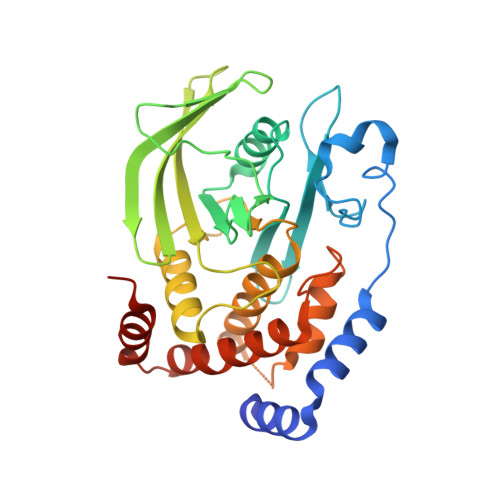PTP1B inhibition suggests a therapeutic strategy for Rett syndrome.
Krishnan, N., Krishnan, K., Connors, C.R., Choy, M.S., Page, R., Peti, W., Van Aelst, L., Shea, S.D., Tonks, N.K.(2015) J Clin Invest 125: 3163-3177
- PubMed: 26214522
- DOI: https://doi.org/10.1172/JCI80323
- Primary Citation of Related Structures:
4Y14 - PubMed Abstract:
The X-linked neurological disorder Rett syndrome (RTT) presents with autistic features and is caused primarily by mutations in a transcriptional regulator, methyl CpG-binding protein 2 (MECP2). Current treatment options for RTT are limited to alleviating some neurological symptoms; hence, more effective therapeutic strategies are needed. We identified the protein tyrosine phosphatase PTP1B as a therapeutic candidate for treatment of RTT. We demonstrated that the PTPN1 gene, which encodes PTP1B, was a target of MECP2 and that disruption of MECP2 function was associated with increased levels of PTP1B in RTT models. Pharmacological inhibition of PTP1B ameliorated the effects of MECP2 disruption in mouse models of RTT, including improved survival in young male (Mecp2-/y) mice and improved behavior in female heterozygous (Mecp2-/+) mice. We demonstrated that PTP1B was a negative regulator of tyrosine phosphorylation of the tyrosine kinase TRKB, the receptor for brain-derived neurotrophic factor (BDNF). Therefore, the elevated PTP1B that accompanies disruption of MECP2 function in RTT represents a barrier to BDNF signaling. Inhibition of PTP1B led to increased tyrosine phosphorylation of TRKB in the brain, which would augment BDNF signaling. This study presents PTP1B as a mechanism-based therapeutic target for RTT, validating a unique strategy for treating the disease by modifying signal transduction pathways with small-molecule drugs.


















